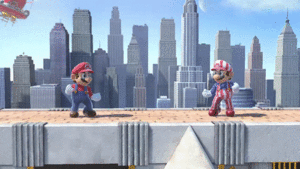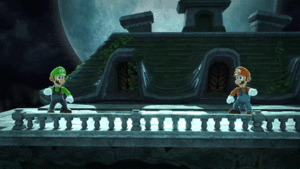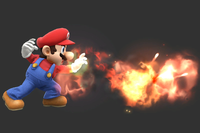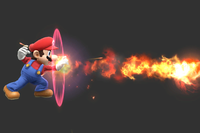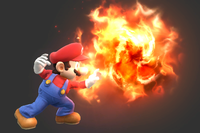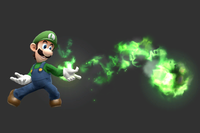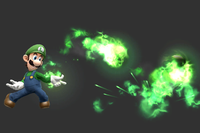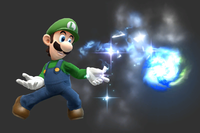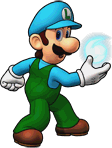Fireball
| Fireball | |
|---|---|
Fireball in Ultimate. | |
| Users | Mario Luigi |
| Universe | Mario |
| Article on Super Mario Wiki | Fireball |
Fireballs (ファイアボール, Fireball) are small projectiles launched by Mario and Luigi as their neutral special moves. Each travels a short distance, does minor damage, and causes flinching common to flame-based attacks. The fireball's trajectory changes according to the stage's surface angle upon contact, though with different results for each character.
Mario's Fireball overview[edit]

Mario shoots a red fireball out of the palm of his hand. The fireballs fall down until they hit the ground, which will cause them to bounce off of the ground. They will bounce a few times before disappearing completely. This makes them more effective when fired from higher locations and toward downward slopes, traveling further. They are especially useful when used in the air, as Mario can control his aerial trajectory while using Fireballs. When firing at a wall or upward slope, the balls will bounce backward, which can be used as a more defensive maneuver for brief protection from oncoming foes, perhaps in the air or from behind (although this is naturally hardly ever practical in competitive play).
In Super Smash Bros.[edit]
In Super Smash Bros., Mario's fireballs come out on frame 16 with the animation lasting 45 frames, they are fairly large, last a long period of time (139 frames; just under 2 1/3rds of a second) and deal 7%. This makes them a rather effective camping tool when used in the air, as Mario can use them on stage to approach and stuff out his opponent's approaches. He can also use the move in a recovery situation, to force his opponent to play around his fireballs, making him harder to edgeguard. Overall, Fireball is a useful tool Mario has, being useful as a camping and recovery tool, as it forces his opponent to play differently to avoid his fireballs.
In the Japanese version, Mario's fireballs dealt more knockback, although they dealt less damage (6% as opposed to 7%) and hitlag.
In Super Smash Bros. Melee[edit]
In Super Smash Bros. Melee, Mario's Fireball has a new animation where Mario opens up his hand when he releases the fireball. This new animation is two frames faster which naturally allows Mario to throw out fireballs faster. The fireballs themselves have seen a visual update where they look slightly more realistic. The fireballs also travel noticeably faster when they hit the ground, making them harder to avoid from long distances.
However, the fireballs have seen numerous downgrades which make them less effective overall. Firstly, the fireballs themselves are smaller and they do not last as long (lasting nearly half the amount of time they did in the previous game). While their increased speed when bouncing compensates for the grounded version, this noticeably hinders the aerial version of the move, making them less likely to hit opponents from afar. The smaller size of the fireballs also makes them noticeably easier to avoid and when combined with Mario's higher falling speed, this makes them much less useful for recovering. The fireballs also deal less damage and knockback (regaining their Japanese damage value but dealing even lower knockback), making them less rewarding when they do land.
Overall, fireballs are less effective than they were in the previous game as they are easier to avoid, they are weaker and they overall do not work as well with Mario's altered aerial mobility. They are still a useful tool overall but they are not as potent as they were in Smash 64.
In Super Smash Bros. Brawl[edit]
In Super Smash Bros. Brawl, Fireball has seen some additional changes. One negative change the move received is that the fireballs have a lower bounce multiplier as they bounce off the ground. This results in Fireballs travelling less distance, further hindering their use as a long range camping tool. The fireballs also deal less damage and hitlag.
However, fireballs have also seen some improvements. The fireballs themselves deal more knockback (although they do deal less knockback as they travel further) and due to Mario's greater aerial mobility, they are overall a safer camping tool.
Fireballs overall are a decent projectile, as well as a decent tool Mario has although it is outclassed by other projectiles.
In Super Smash Bros. 4[edit]
In Super Smash Bros. 4, Mario's Fireballs are more realistically designed, with smoke and ashes coming out of the flames. Fireballs have also seen some changes to their functionality. The most beneficial change is that they have a greater bounce velocity multiplier, making them cover much more distance on the ground.
The fireballs are noticeably heavier than they were in Brawl which makes them fall to the ground a lot faster. This alters their utility, making them superior in some situations but worse in others. The fireballs also always bounce at the same height now and they have different knockback values.
Fireball has seen some downgrades however. The move has more startup and ending lag, making it less spammable (especially in the air). In addition to this, the fireballs last a shorter amount of time (5 frames less), they are smaller and they deal less damage from a far distance.
Overall, Fireballs are still useful with their changes, being a decent projectile to deal with opponents from a distance.
In Super Smash Bros. Ultimate[edit]
In Super Smash Bros. Ultimate, Fireball has seen multiple improvements. The move has less ending lag (albeit still more than in Melee and Brawl), the fireballs are now as large as they were in Brawl and it has more hitlag, improving its followup potential. A negative change the move did receive in update 3.0.0 however is that like with many other projectiles, it deals less shield damage.
Overall, this makes Fireball more effective than it was in Smash 4 as the move is faster and the fireballs are easier to land.
Luigi's Fireball overview[edit]
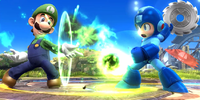
Luigi's fireballs differ from Mario's in a few ways. The fireballs themselves are green and they travel in a straight line, being unaffected by gravity (matching his floaty motif) and they drift around in a circle, rather than rolling and bouncing along the ground like Mario's. Despite the fact that Luigi's fireballs are green, they still have a normal flame effect, so opponents are still burnt in orange flames like any other flame attack. If the fireballs hit a terrain, they will bounce in a different direction, depending on the angle of the terrain. Due to its different launch trajectory, Luigi's fireballs are typically less useful than Mario's, as their straight arc overall gives them less utility (since they cannot be used to deal with opponents below Luigi and they are overall more predictable). They do have some advantages over Mario's however; they do slightly more damage (in Brawl, Smash 4, and Ultimate), are more spammable, and have more vertical range.
In Super Smash Bros.[edit]
In Super Smash Bros., Luigi's fireball uses the same animation as Mario's, making the attack the same speed. The fireballs themselves are the same size as Mario's although as mentioned before, they are green and travel in a straight line. In addition to this, they only deal 6%, 1% less damage than Mario's (outside of the Japanese version) and they do not last for nearly as long (only lasting 79 frames compared to Mario's which last 139 frames).
Luigi's fireballs can still be used to camp but they are less effective for this purpose than Mario's due to their shorter duration. In general, Luigi's fireballs are not highly effective as a projectile and they are overall less versatile than Mario's due to their straight arc, although it is still a decent tool Luigi possesses.
In the Japanese version, Luigi's fireballs were more effective, dealing more knockback and lasting for 10 more frames, making them travel a greater distance.
In Super Smash Bros. Melee[edit]
In Super Smash Bros. Melee, Luigi's fireballs have seen the same visual update as Mario's (as well as naturally still being green) and the move now has a completely different animation to Mario's, where Luigi brings back his left/leading hand in a covering position and gestures it forward in a finger snap to release the fireballs. This animation however is one frame longer than the previous animation, which makes Luigi's fireballs three frames slower than Mario's.
The fireballs themselves travel faster however, they have a shorter duration (50 frames compared to 79), they are smaller and they deal less knockback. This overall makes fireballs less effective by themselves, as they come out slightly slower and they are smaller and weaker. The fireballs are now the same strength as Mario's (much like in the Japanese version of Smash 64) although they are now smaller than Mario's.
However, Fireball has gained some extra utility when used in conjunction with wavedashing, as Luigi can now easily and quickly approach or back away while using Fireball. While performing the move during a wavedash, Luigi can slide off from a platform, which preserves his horizontal momentum, allowing him to travel the stage relatively quickly. This technique is called a Vududash, after the smasher Vudujin.
Overall, while Fireball was mostly nerfed, it notably benefits from the introduction of wavedashing, improving its utility and effectiveness despite its nerfs.
In Super Smash Bros. Brawl[edit]
In Super Smash Bros. Brawl, Fireball remain similar to how it was in Melee although it has seen some improvements. The fireballs themselves are larger, they travel slightly faster and the move has 6 frames less ending lag. Because of this, Luigi's fireballs are now larger than Mario's and while they still have increased startup lag, they now have lower ending lag, making them more spammable overall. The move can also now bounce off of multiple walls. In the previous two games, the fireball would prematurely disappear if it hit a second wall although that is no longer the case in Brawl, as the fireball will now simply bounce off the wall again.
Because the fireballs retained their strength from Melee, they now deal more damage than Mario's and unlike Mario's, they remain consistently strong throughout their duration. Two downsides the move did receive though is that the fireballs last for two less frames and the move naturally suffers from the removal of wavedashing.
Nevertheless, Luigi's fireballs have been improved overall in Brawl as they are larger and more spammable, although the move does have less utility than before due to the removal of wavedashing.
In Super Smash Bros. 4[edit]
In Super Smash Bros. 4, Fireball was initially almost unchanged from Brawl, with the only difference (besides having a visual redesign along with Mario's) being that they dealt marginally higher knockback. This meant that fireballs continued to be fast and spammable projectiles, especially in comparison to Mario's (whose fireballs now have the same startup lag as Luigi's, in addition to having higher ending lag).
However, Fireball received two nerfs over Smash 4's life cycle. The first nerf came in version 1.0.6 where the move received 3 more frames of ending lag. This meant that they were not as spammable as they were before but they were still faster than Mario's. The second nerf came in 1.1.0 where after 29 frames (around half a second) of being active, the fireballs would become weaker, dealing 1% less damage and dealing less hitlag. This made fireballs less effective from afar, as they would now deal the same amount of damage as Mario's from long distances.
Overall, Fireball is less effective than it was in Brawl (after the updates) although it is still a decent projectile overall.
In Super Smash Bros. Ultimate[edit]
Fireball remains mostly the same in Super Smash Bros. Ultimate although it has received a few minor changes. One positive change is that the fireballs now last for two extra frames (much like Melee). One negative (albeit negligible) change however is that the move has a revamped animation, which is longer than the previous animation. Because of this new, longer animation, Luigi cannot grab ledges as soon, although this is overall an extremely minor hindrance. Another more substantial negative change came in version 3.0.0 where much like Mario's fireballs along with other projectiles, the fireballs deal less shield damage.
Nevertheless, Fireball remains a rather similarly effective tool to how it was in Smash 4 although it does not outclass Mario's fireballs as much due to the buffs his fireballs received in comparison.
Customization[edit]
Special Move customization is available in Super Smash Bros. 4. These are the variations:
Mario[edit]
- Fireball: Default.
- Fast Fireball (高速ファイアボール, High-Speed Fireball): The performance of the move is much faster, having about half the startup time, and somewhat less ending lag, allowing the move to be used in succession. The fireball itself travels directly forward at high speed, but causes very little knockback and inflicts less damage. The fireballs are also slightly smaller, and travel half the length of Final Destination.
- Fire Orb (巨大ファイアボール, Giant Fireball): Is much larger, moving slowly in an arc, and travelling about a quarter of the length of the default move. It has transcendent priority, and is a multi-hit move, which can be useful for follow-ups. However, it has more than double the startup lag and much more ending lag, giving the move an overall very long duration, subsequently making it unsafe to use offstage.
Fast Fireball in Super Smash Bros. for Nintendo 3DS
Fire Orb in Super Smash Bros. for Nintendo 3DS
Luigi[edit]
- Fireball: Default.
- Bouncing Fireball (バウンドファイアボール, Bound Fireball): Allows Luigi's fireballs to bounce on the ground, acting much like Mario's, with each successive bounce decaying in height. The fireballs do less damage as they travel further, going from 6% to 5%, then to 4%. The move has more than double the ending lag, however, and comboing with it is more difficult.
- Iceball (アイスボール, Ice Ball): The startup lag on the move is noticeably longer. The ball itself is a white/blue color, and moves through the air in a small circular motion rather than a large semi-circular one. The overall horizontal movement and range of the ball is decreased, and deals only 4% damage. However, the ball deals noticeably more knockback, and has the ability to freeze opponents starting from around 40-50% depending on the opponents weight. The ball itself also has a larger hitbox (2.4u -> 3.5u), and lasts a lot longer, allowing for a degree of stage control. Fires at a slightly upward angle.
Luigi's Bouncing Fireball being used in Super Smash Bros. for Nintendo 3DS
Luigi's Iceball being used in Super Smash Bros. for Nintendo 3DS
Instructional quotes[edit]
| Shoot bouncing balls of fire horizontally. They vanish as they slow. | ||
| Shoot a bouncing fireball that disappears once it loses speed. | ||
| Shoot fireballs from your palm. | ||
| Shoot a fireball that flies straight ahead. | ||
| Throws a fireball that bounces along the ground. | ||
| Throws a fireball straight ahead that bounces if it hits a wall or the ground. |
Origin[edit]
Fireball[edit]

Fireballs were introduced in the game Mario Bros. Red and green fireballs would periodically travel across the screen as hazards. The red fireballs moved in a random pattern, being affected by gravity, and the green fireballs moved in a straight path, not being affected by gravity at all. Only the green ones appear in Brawl's version of the stage, but they start out as red/purple before moving. They can be destroyed for points with Mario and/or Luigi bumping them from underneath with a jump should they be close enough to the platform above.
Although fireballs appeared in Mario Bros., the act of shooting fireballs originated in the 1985 game, Super Mario Bros., where the ability was obtained after collecting a Fire Flower. The power is lost when the player dies or takes damage. In the game, fireballs were small, traveled very quickly, and did not stop until they hit something. Also, in this game and other traditional Mario games, Luigi's fireballs are not unique, being red in color and behaving exactly like Mario's. In most games, only two fireballs could be on-screen at a time even if one could be rapid-fired after another. Luigi's green fireballs made their debut in the Super Smash Bros. series, inspired by their appearance in Mario Bros., but reappear later in the Mario spin-offs such as Mario Kart: Double Dash!!, Mario Superstar Baseball, and Mario Hoops 3-on-3.
A Fire Flower would also change the character's clothing colors, depending on the game. Usually, Mario's overalls became red, while Luigi's turned green, both with white shirts and caps. These color schemes are available as alternate costumes for Mario and Luigi in Super Smash Bros. Brawl and Super Smash Bros. 4 and only Luigi in Super Smash Bros. Ultimate.
Fire Orb[edit]
One of Mario's custom moves, Fire Orb, possesses the same name and a similar appearance as one of his special attacks from Super Mario RPG: Legend of the Seven Stars (renamed Fireball in the Nintendo Switch remake), but it functions differently from the attack in that game.
Iceball[edit]
One of Luigi's custom moves, Iceball, is based off of Ice Luigi from New Super Mario Bros. Wii and New Super Mario Bros. U.
Gallery[edit]
Mario[edit]
Mario's Fireball in Super Smash Bros. for Nintendo 3DS.
Mario's Fireball in Super Smash Bros. for Wii U.
Luigi[edit]
Luigi's Fireball in Super Smash Bros. for Nintendo 3DS.
Luigi's Fireball in Super Smash Bros. for Wii U.
Other[edit]
Mario and Luigi throwing Fireballs in Super Smash Bros. for Wii U.
Names in other languages[edit]
Trivia[edit]
- In Smash 64, at one very specific point in the move just when Mario throws the Fireball, his character model will turn completely red. This lasts for only a few frames. The same thing occurs with Luigi.
- In Super Smash Bros. 4, upon Mario's Fireballs hitting an opponent, they produce the same sound as when enemies are defeated in the original Super Mario Bros. Luigi's Fireballs do not have this property.
- The change made to Luigi's Fireball in the 1.0.6 version of Smash 4 resulted in one of the tips for the move having to be changed, as it originally mentioned that unlike Mario's Fireball, Luigi's doesn't deal less damage when travelling further.
- Despite Luigi's Fireballs being green, they make red-orange burn animations upon impact with a character, as they use a standard flame hit effect.
